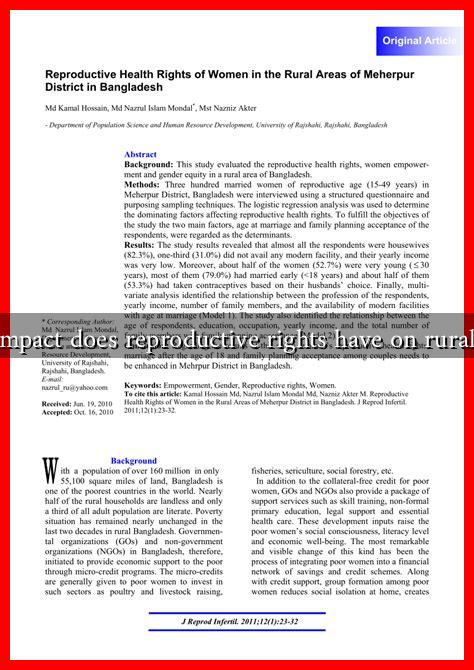-
Table of Contents
The Impact of Reproductive Rights on Rural Areas
Reproductive rights encompass a range of issues related to the ability of individuals to make informed choices about their reproductive health. In rural areas, where access to healthcare services can be limited, the implications of reproductive rights are particularly significant. This article explores the multifaceted impact of reproductive rights on rural communities, highlighting the challenges faced and the potential benefits of improved access to reproductive healthcare.
Understanding Reproductive Rights in Rural Contexts
Reproductive rights include the right to access contraception, safe abortion services, and comprehensive sex education. In rural areas, these rights are often compromised due to various factors:
- Limited Healthcare Facilities: Many rural regions lack adequate healthcare facilities, making it difficult for individuals to access reproductive health services.
- Transportation Barriers: Long distances to healthcare providers can deter individuals from seeking necessary services.
- Socioeconomic Factors: Economic constraints can limit access to reproductive health services, particularly for low-income individuals.
- Cultural Attitudes: Traditional beliefs and stigma surrounding reproductive health can further inhibit access to services.
The Consequences of Limited Reproductive Rights
The lack of access to reproductive rights in rural areas can lead to several adverse outcomes:
- Increased Unintended Pregnancies: Limited access to contraception can result in higher rates of unintended pregnancies, which can strain resources and impact family dynamics.
- Higher Maternal Mortality Rates: Rural areas often experience higher maternal mortality rates due to inadequate prenatal and postnatal care.
- Economic Impact: Unintended pregnancies can lead to economic instability for families, affecting their ability to work and support themselves.
- Health Disparities: Rural populations may face greater health disparities, including higher rates of sexually transmitted infections (STIs) and lower rates of preventive care.
Case Studies: The Rural Reproductive Rights Landscape
Several case studies illustrate the impact of reproductive rights on rural communities:
- Planned Parenthood in Rural America: In states like Texas, the closure of Planned Parenthood clinics has significantly reduced access to reproductive health services, leading to increased rates of unintended pregnancies and STIs.
- Telehealth Services: The rise of telehealth has provided some relief in rural areas, allowing individuals to access reproductive health consultations remotely. A study by the American Journal of Public Health found that telehealth services increased access to contraception in rural populations.
- Community Health Initiatives: Programs like the Rural Health Network in New York have successfully increased awareness and access to reproductive health services through community outreach and education.
Benefits of Improved Reproductive Rights Access
Enhancing reproductive rights in rural areas can yield numerous benefits:
- Empowerment: Access to reproductive health services empowers individuals to make informed choices about their bodies and futures.
- Economic Stability: Reducing unintended pregnancies can lead to greater economic stability for families, allowing them to invest in education and career opportunities.
- Improved Health Outcomes: Increased access to reproductive healthcare can lead to better maternal and child health outcomes, reducing mortality rates.
- Community Development: Healthier families contribute to stronger communities, fostering economic growth and social cohesion.
Conclusion: The Path Forward
The impact of reproductive rights on rural areas is profound and multifaceted. Addressing the barriers to access can lead to significant improvements in health outcomes, economic stability, and overall community well-being. Policymakers, healthcare providers, and community organizations must work collaboratively to enhance reproductive health services in rural areas. By prioritizing reproductive rights, we can empower individuals and foster healthier, more resilient communities.
For more information on reproductive rights and access to healthcare, visit Planned Parenthood.


